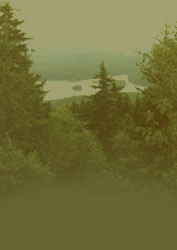|
Do you have something
happening in your corner of Washington? - Please call a member
or e-mail your observations to have them included here
December:
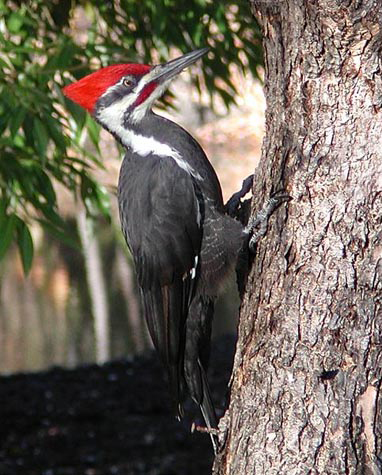
Pileated woodpeckers are the largest of the common woodpeckers found in North America. Body size 16 to 19 in. wingspan, 26 to 30 in and weight: 8.8 to 12.3 oz.
These crow-sized birds present a memorable sight with their zebra-striped heads and necks, long bills, and distinctive red crests.
Pileated woodpeckers forage for their favorite meal, carpenter ants, by digging large, rectangular holes in trees.
These holes can be so large that they weaken smaller trees or even cause them to break in half. Other birds are
often attracted to these large openings, eager to access any exposed insects.
Pileated woodpeckers do not discriminate between coniferous
and deciduous trees—as long as they yield the ants and beetle
larvae that make up much of the birds' diet. It uses its long,
sticky tongue to poke into the holes and drag out the ants.
Woodpeckers sometimes access these morsels by peeling long
strips of bark from the tree, but they also forage on the
ground and supplement their diet with fruits and nuts. Although
the pileated woodpecker is adapted to clinging to the sides
of trees, it is a strong flyer and it will even sometimes
hop around on the ground.
The call is a wild laugh, similar to the Northern Flicker. Their enthusiastic drumming sounds
like a loud hammering, and is audible for a great distance. Woodpeckers also drum to attract
mates and to announce the boundaries of their territories. Pairs establish territories and live on them all year long.
The birds typically choose large, older trees for nesting and usually inhabit a tree hole.
In eastern North America, pileated woodpeckers declined as their forest habitats were
systematically logged in the 19th and 20th centuries. In recent decades, many forests
have regenerated, and woodpecker species have enjoyed corresponding growth. The birds
have proven to be adaptable to changing forest conditions.
The Pileated Woodpecker was the model for the cartoon character Woody Woodpecker.
This information and more can
be found at:
NH
National Geographic Animals
November:

Don was walking in the woods near his house last month when
he looked down and picked up something that looked like a
green sea urchin (spines and all), he looked around the ground
and saw another. Puzzled about what these were, he looked
up and realized that the tree he was standing next to was
an American Chestnut! It appeared to be very
healthy and was making chestnuts.
Almost all of the American Chestnuts
were killed by a blight that began attacking them early in
the 1900s. The fungus was likely introduced to North America
on nursery stock from Asia and was first observed killing
trees in the Bronx Zoo, in New York City in 1904. From there,
Chestnut blight spread rapidly through eastern North America,
and across the entire natural range of the Chestnut. An estimated
4 billion American chestnuts, one quarter of the hardwood
tree population, grew within this range.
The American chestnut
tree was an essential component of the entire eastern US ecosystem.
A late-flowering, reliable, and productive tree, unaffected
by seasonal frosts, it was the single most important food
source for a wide variety of wildlife from bears to birds.
Rural communities depended upon the annual nut harvest as
a cash crop to feed livestock. Although the nuts are smaller
than other kinds of chestnut, they are very delicious.
The
chestnut lumber industry was a major sector of rural economies.
Chestnut wood is straight-grained and easily worked, lightweight
and highly rot-resistant, making it ideal for fence posts,
railroad ties, barn beams and home construction, as well as
for fine furniture and musical instruments.
Early attempts at controlling Chestnut blight involved crossing
the Chinese Chestnut with the American Chestnut, in hopes
that some of the hybrids would show resistance as well as
the upright form of the American Chestnut. It wasn't very
successful. Recently, a new program involving several generations
of backcrosses to the American chestnut was initiated in another
attempt to breed resistance with good tree form. The American
Chestnut Foundation is working hard to bring back this magnificent
tree.
Visit their website to learn more: American Chestnut Foundation
And watch out for those "sea urchins" in the woods!
October:
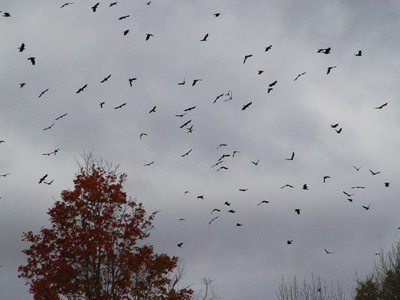
Jed heard and then saw a large "roost"
of crows in East Washington. Just before he took
this picture he said there were literally ten times as many
birds sitting in the trees and he caught this big group as
they were taking off. They may have been chatting about the
great meal they just ate in the Eccard's corn fields.
The crow is a big, glossy, black colored bird approximately
17 to 20 inches long with a strong stout build and a compressed
bill. On a bright sunny day, crows sometimes look dark purple.
They range all over North America, and are well-adapted to
diverse habitats.
They thrive in mountains, woodlands, across plains and farmers'
fields, and throughout urban areas. They are omnivorous -
they will eat anything edible, and many things which aren't.
Their regular diet includes animal and vegetable matter, insects,
crops (especially corn), and occasionally the eggs or young
of other birds. They also scavenge carrion, garbage, and eat
wild and cultivated fruit and vegetables.
Despite their bad reputation for eating crops, crows also eat a number of pests which are
harmful to those same crops, including cutworms, wireworms, grasshoppers and even noxious weeds.
The crow is one of the most intelligent of all birds.Their
intelligence is apparent in their ability to communicate a
wide range of messages with their call. A crow can communicate
warning, threat, taunting, and cheer to other crows by varying
the “CAW” sound it makes. Their cries of warning are specific
enough that some animals other than crows are also able to
use them as signals of dangerous predators.
They will congregate into huge flocks of up to several thousand
in fall and winter. These large flocks are the result of many
small flocks gradually assembling as the season progresses,
with the largest concentration occurring in late winter.
Crows are smart, quite adaptable and noisy neighbors that
can be lots of fun to observe.
September:
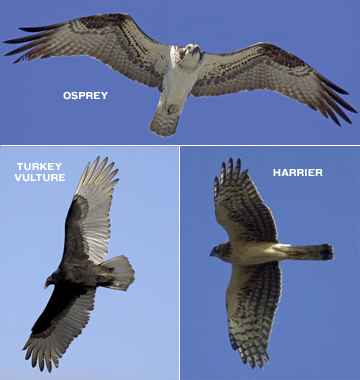
Photos by Lillian Stokes
September is considered by many birdwatchers as the month
of the Hawk, for it is when hawk migration
is at its peak. Hawks journey over many thousands of miles
from their summer breeding grounds to their winter quarters
and many of them travel together.
The birds known as diurnal raptors are birds of prey that
are sometimes referred to simply as “hawks.” They include
eagles, falcons, ospreys, kites and harriers as well as hawks.
Among thirty-two species that occur regularly in North America,
at least twenty are migratory moving seasonally to exploit
food resources. They range in size from the diminutive American
kestrel (not much bigger than a robin) to the massive bald
eagle with a wingspan of more than six and a half feet.
Many of these birds travel long distances, migrating from
Canada to South America. During these annual migrations they
often gather in huge numbers along coastlines and mountain
ridges where geography and local weather interact to bring
them together. At these special places, biologists, citizen
scientists, birdwatchers, and the interested public also gather
to identify and count these raptors or simply to enjoy one
of nature’s most magnificent spectacles.
One place you can do this locally is New Hampshire Audubon's
Pack Monadnock Raptor Migration Observatory, located
on the summit of Pack Monadnock in Miller State Park in Peterborough.
Pack Monadnock is one of several locations in the state where
large numbers of migrating hawks are regularly seen in the
fall; more than 10,000 hawks were counted from the Observatory
in 2006. The auto road to the summit parking lot in Miller
State Park allows almost anyone to reach the Observatory and
experience this spectacle firsthand.
A short improved trail leads from the parking lot to the site
of the Observatory where there is a stable outdoor observation
platform with rock benches. Large interpretive panels describe
the project and provide visitors with a full-color key to
identifying the raptors of New England. The best days for
viewing are warm and sunny, with winds from the northwest,
especially during early to mid-September. The Observatory
is open and staffed every day from September 1 to October
31. You are invited to visit and watch the show of migrating
hawks and learn all about it.
This information and more can
be found at:
NH
Audubon Migrating Hawks
August:
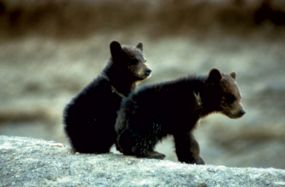
Photo by the National Park Service
Someone mentioned seeing a pair of bear cubs
out near Journey's End. Mama bear wasn't spotted but chances
are she was near by.
Bear cubs are born in winter dens during January after a gestation
period of about 8 months. Newborn cubs are born hairless,
with eyes closed, measuring 6-8 inches in length, and weigh
less than 1 pound. Cubs stay with their mother for approximately
18 months and den with her again during the following winter.
When they are a year and a half old, cubs leave their mothers
prior to the June/July mating season.
Mother bears are rarely aggressive toward humans, but they
are protective of their cubs. A mother bear will usually give
many warning signs (huffing or popping sounds, swatting the
ground or even bluff charges) to let you know that you are
too close. Move away as described below.
If you see a bear, keep your distance. Make it aware of your
presence making sounds. If you get too close to a bear, it
may slap the ground, huff, blow and chomp its teeth or rush
you (this is referred to as "bluff charge") in an attempt
to get you to move a more comfortable distance away. If this
occurs, maintain eye contact with the bear, speak in a soft,
calm voice and slowly back away from the bear. These actions
will help appease the bear and show that you are not weak,
but, at the same time, not a threat to the bear. Do not run,
avert your eyes or turn your back to the bear. The bear may
perceive weakness and enforce dominance. The bear's bluff
charge and chomping of teeth are a defense mechanism to establish
the bear's dominance in an encounter with humans or a more
dominant animal in the wild. Bears can outrun, out-swim and
out-climb you. If you are attacked by a black bear, you should
fight back rather than "play dead."
Black bears are capable of killing people, but it is an extremely
rare occurrence. The last time someone was killed by a black
bear in New Hampshire was 1784. Black bears, like all wild
animals, should be treated as unpredictable animals.
Here are a few tips:
• Normal trail noise should alert bears to your presence
and prompt them to move without being noticed. However, if
you see a bear, keep your distance. Make it aware
of your presence by clapping, talking or making other sounds.
• If a bear does not immediately leave after seeing
you, the presence or aroma of food may be encouraging it to
stay. Remove any sight or smell of foods.
Place food items inside a vehicle or building. Occupy a vehicle
or building until the bear wanders away.
• Black bears will sometimes "bluff charge" when cornered,
threatened or attempting to steal food. Stand your
ground and slowly back away.
• Enjoy watching black bears and other wildlife
from a distance. Respect them and their right to
live in wild New Hampshire.
• Black bears do not typically exhibit aggressive
behavior, even when confronted. Their first response
is to flee. Black bears rarely attack or defend themselves
against humans.
This information and more can
be found at:
NH
Wildlife Bear Facts
Learn
to Live With Bears
Frequently
Asked Bear Questions
July:
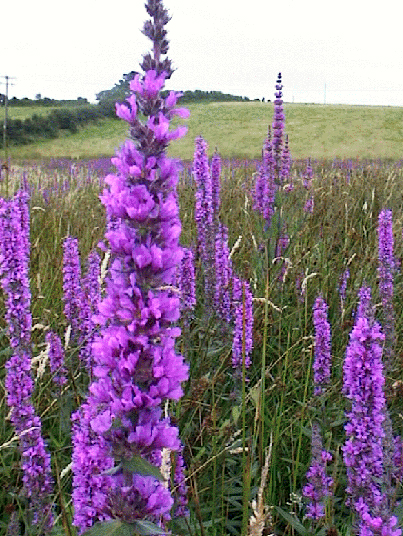
Purple loosestrife is
native to Eurasia. It was originally introduced to eastern
North America in the early to mid 1800's. One of the most
persistent invasive plant species in New Hampshire is also
widely regarded as one of the most beautiful.
It is a perennial herb with a square, woody stem and opposite
or whorled leaves that grows to between 3 and 6 feet tall.
Purple loosestrife flowers from July through August in New
Hampshire, and is named for its bright purple flower that
spikes from the top of the plant. One plant may grow as an
individual stalk or as several stalks clumped together.
Invasive plants share several characteristics that help them
thrive and dominate in new environments. Most invasive plants
produce a lot of seed-a single purple loosestrife plant can
produce 2 million viable seeds per year, have aggressive root
systems, colonize in disturbed areas, and are habitat generalists.
Optimum habitats include freshwater marshes, open stream margins,
and alluvial floodplains. Purple loosestrife also occurs in
wet meadows, river banks, and edges of ponds and reservoirs.
It favors fluctuating water levels and other conditions often
associated with disturbed sites, such as construction sites
for docks or marinas. Purple loosestrife is often associated
with cattail, reed canary grass, and other moist soil plants.
Purple loosestrife is a problem because it negatively affects
wildlife and agriculture. Purple loosestrife displaces and
replaces native flora and fauna, eliminating food and shelter
for wildlife. By reducing habitat size, purple loosestrife
has a negative impact on fish spawning and waterfowl habitats.
The plant also diminishes wetland recreational capability.
Purple loosestrife affects agriculture by blocking flow in
drainage and irrigation ditches and decreasing crop yield
and quality.
If you find purple loosestrife pull or dig it up, first year
plants are easy to pull. It can be difficult to pull established
plants, owing to the extensive root mat. Plants will resprout
unless the entire root is removed by digging. Time your attack
before it flowers or just as it starts flowering from the
bottom up. Later than this allows the plant to make seeds
which spread quickly. If you need to see the flowers before
digging, do so but burn or bag your Loosestrife for disposal.
Do NOT compost it.
More information can be found
at:
NH
DES site
NH
DOT Report on Purple Loosestrife
Invasive
Plants in the Upper Valley
June:
Turtles!
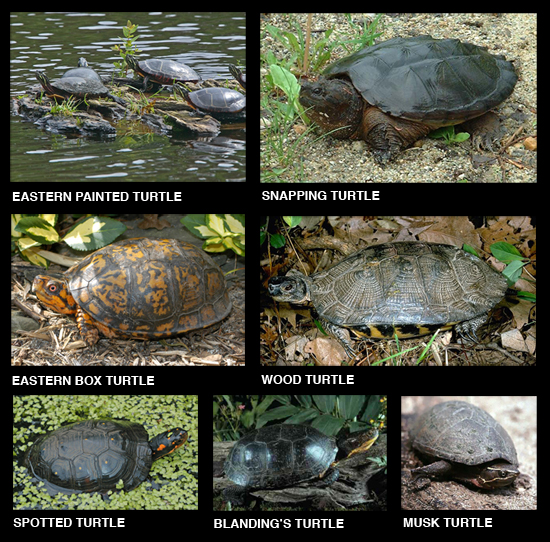
What to do if you find a turtle
crossing the road
From the end of May to the end of June, New Hampshire motorists
and pedestrians are very apt to meet turtles in the middle
of the road. At this time of year, they are females out to
lay eggs, a biological imperative that must be obeyed. Often
people have a commendable desire to help these slow-moving
creatures out of a risky situation. In that case, it is best
to move the turtle to a safe place in the direction in which
she was heading. It is also important to keep in mind that
turtles have a home range and females often return to the
same general area to lay eggs. Removing the turtle from the
place where she is found and taking her to an area that seems
"safer" is therefore not a good idea.
Snapping turtles tend to be out early in
the day. These are large, solid-colored turtles with pointed
heads and a line of bumpy spines going down the center of
their long tails. Although smaller ones may be safely carried
by the tips of their tails with outstretched arm and the bottom
shell (plastron) facing you, treating larger ones this way
may cause injury to their tails and they should be carried
by their back legs instead. Given their surprisingly long
necks and strong jaws, however, many of us feel hesitant about
getting up this close and personal. If traffic is light enough
to make it possible, use a stick to gently tap the edge of
the shell near the tail to try to hasten the turtle to the
side of the road. Bear in mind that a turtle, even when hastening,
isn't moving very fast. If this is not feasible, it might
be a good idea to keep a snow shovel in your car for carrying
purposes. After all, who is to say that it won't snow in New
Hampshire in May or June?
In the afternoon the turtle most often met is the familiar
Eastern Painted Turtle with yellow and red
head markings and red on the edges of the top shell (carapace).
This species does not pose any danger. If small, the painted
turtle may be safely lifted and carried by the edges of her
shells with one hand; larger ones should be moved using two
hands with the fingers holding the bottom shell and the thumbs
on the top. Most painted turtles respond to being lifted by
tucking themselves into their shells but some are apt to move
their feet rapidly in an effort to escape. Be prepared for
this reaction so you are not startled into dropping the turtle
and causing harm. - This information
and more found at: NH
Audubon Society
More about turtles:General
information on turtles of New Hampshire
Information
on turtle conservation
May:

American Kestrel,
Photo credit: USFWS
Mark had an American Kestrel hang out with
him for about 5 hours when he was working outside one day.
He said it was not shy at all and kept landing on his equipment
(which was running at the time) and flying around between
the barn and the yard. Carol said that Kestrels like to hang
out around farms eating small rodents and birds, and bugs.
They are approximately 9-12" in size and recognizable in all
plumages by a rusty tail and back. The adult male has slate-blue
wings and the female has rusty wings and back with narrow
bands on tail. Both sexes have 2 black stripes on face.
Unlike larger falcons, the "Sparrow Hawk" has adapted to humans
and nests even in our largest cities, where it preys chiefly
on House Sparrows. In the countryside it takes insects, small
birds, and rodents, capturing its prey on the ground rather
than in midair like other falcons. Kestrels are active during
the day and prefer an "open country" habitat found in fields,
heaths, and marshland. When hunting, the Kestrel hovers, almost
stationary, about 10-20 m above the ground searching for prey.
Once prey is sighted, the Kestrel makes a short, steep dive
toward the target.
Kestrels use old nests of other birds or nest in holes in
trees, cliff ledges or even man-made structures, such as bridges.
3-5 eggs are laid around late April to May, with about two
days between each egg. The female does most of the incubating
and is fed by the male. The male calls as he nears the nest
with food; the female flies to him, receives the food, and
returns to the nest. After the eggs hatch, the male continues
to bring most of the food. The young stay with the adults
for a time after fledging, and it is not uncommon to see family
parties in late summer.
April:

This picture of Earth is provided by NASA's
Terra satellite. Terra is the flagship of NASA's Earth Observing
System, a series of satellites gazing down on our planet from
the unique vantage point of space. You can find more beautiful
shots of our planet here:
NASA Terra and
Visible Earth
In honor of Earth Day on April 22nd why don't
we all try to "Go Green" in a few little
ways to help out the earth and conserve our natural resources.
The following are web links with suggestions for a few things
you can do every day to help fight waste and warming and make
your environmental footprint smaller.
Here are some "GO GREEN" web links:
Tree Hugger
guides - "Tree Hugger's guides to going green" Tons
of guides and tips for going green. Don't be afraid of this
one just because it's called "Tree Hugger", there is a wealth
of information here on many subjects.
GreenWorksGov - GreenWorksGov is a blog about how to organize a “green office” program and what to do to make “green” a reality.
World Watch
Tips - "Ten ways to go green and save green"
Recycling tips - All about recycling, what it is , how to do it, why it is important
the
EPA's Green Shopping tips - Ways to go green while
shopping
For Teachers:
Go Green Initiative - Ways to implement a Go
Green Initiative at school and get kids involved in environmental
responsibility
Green work place
choices - Ways to help your workplace make green
choices
Sierra Club's Green workplace choices "10 Ways
to Go Green at Work"
Lighter
Footstep "Ten first steps toward a lighter, more
sustainable lifestyle"
For your Power - Recycle — Save Energy, Resources and the Environment
Eco Friendly
gifts - Eco Friendly Gift Bags
Natural Resources Defense Council - Actions you can take in your daily life
Water Resource Use - Information about wise use of water resources
Water Conservation - Water conservation whys and hows
Solar and Renewable power - Facts about solar energy and renewable resources
For Kids:PBS for kids - PBS site with lots of info, games, and links for kids
EPA's site for Kids of all ages
For Teens:Youth
Noise - Sustainability challenges to live a more
eco-concious lifestyle.
The Story of Stuff - The Story of Stuff project, all about bottled water and more movies
Now go surf the web and see what else YOU can find and good
luck going green! Little changes in your life style add up
to big savings and a healthier planet!
March:
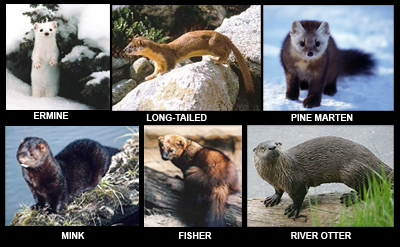
Both Mark and Nan reported recently seeing
weasels running across the snow in different
locations. We wondered what kind of weasels they could be
and we were surprised to find out that New Hampshire has weasels
in abundance with 6 members of the weasel family living here.
Which one of the winter weasels were they? The family includes
(from smallest to largest): Ermine (also known as the short-tailed
weasel), Long-tailed weasel, Pine marten, Mink, Fisher and
River otter. All of these, except the marten, are common to
abundant throughout most of New Hampshire, but most of us
can count on our hands the number of times we have seen any
one of them. They may be abundant, but are scarce to our view.
Two species, the ermine and long-tailed weasel, disappear
nearly completely in winter by turning white as snow! If you
can spot any weasel, then you are doing remarkably well!
Weasels, by their very nature, keep themselves scarce. Most
of them are either most active after dark, or, as in the case
of the otter, are active at first light of morning. They leave
an abundance of sign in our forests or along our rivers. When
the Fish and Game Department did numerous winter snow tracking
census lines in the early 1980s, fishers were the most frequently
observed tracks -- even more common than squirrels! Fisher
are found practically everywhere there is plentiful cover
of softwoods, including our backyards. Their distinctive two-two-two
(: : : :) cantered prints in the snow leave ample signs to
find. Learning the signs of these small predators will open
a whole new world of wildlife for you to discover in your
area.
-- Eric Orff, wildlife biologist,
N.H. Fish and Game
Lots more information about these
6 weasels can be found here: New
Hampshire Fish and Wildlife Website
February:

Mark reports seeing bobcat tracks
up in the hilly, wooded area above the corn field. It appeared
to him that the Bobcat was chasing down a squirrel but wasn't
successful in making a meal of it.
The Bobcat is the last survivor of three
wildcats that once roamed the New Hampshire woods. Mountain
lions (also called cougars, panthers or catamounts) were gone
from the state by the late 1800s. The bobcat's taller cousin,
the lynx, lived in northern New Hampshire through the 1950s.
Today, only the tenacious bobcat is still here. No one knows
for sure, but probably several hundred bobcats still live
in the Granite State. The southwestern corner of New Hampshire
has the most consistent reports of bobcat sightings.
For centuries, bobcats were killed for bounty in New Hampshire,
and by the late 1970s, bobcats had become scarce. New Hampshire's
hunting and trapping seasons for bobcat were finally closed
in 1989. In less than a decade, bobcats went from being bountied
in New Hampshire to being completely protected.
The bobcat population in New Hampshire has increased since
that time, but not by much, because now the state's bobcats
face new challenges. Fishers and coyotes compete with bobcats
for a dwindling prey pool, and encroaching development breaks
up the large blocks of habitat bobcats need. Humans have ushered
in another dangerous element: busy roads that can be deadly
for the wide-ranging animals.
Bobcats often roam between brushy swamp areas and the high-elevation
habitat they prefer. Rocky, south-facing slopes and near-summit
ledges of mountains offer protection, a safe place to raise
kittens and a chance to soak up the sun. The bobcat's only
real social grouping is females with kittens -- usually about
3 to a litter, dependent on their mothers for 9 or 10 months.
This solitary lifestyle means bobcats need space, and lots
of it. Females stake out a territory of about 12 square miles,
and males roam over about 36 square miles. A lot depends on
the availability of food -- snowshoe hare and cottontail rabbits
are the bobcat's favorite, though they will eat mice, chipmunks,
wild turkeys and even an occasional deer. Ongoing efforts
to conserve, connect and manage protected lands continue to
be the best bet for helping New Hampshire's last wildcat survive.
Winter is an especially tough time for bobcats in New Hampshire.
Food is scarce, and the bobcat's short legs and small feet
aren't well suited to hunting in deep snow. Driven by hunger
during the cold months, bobcats sometimes gravitate to barns
and porches in search of food, or stalk birds and squirrels
at backyard feeders. Many young bobcats, as well as some adults,
don't survive winters with long periods of deep, fluffy snow.
Information found at: NH
Wildlife reports
January:

Here's a Bright idea for the new
year!
In the United States, we use one-quarter of our average home
energy budget in electricity for lighting. Most of that electricity
powers incandescent lightbulbs, which are notoriously inefficient.
If you replace your incandescent light bulbs with compact
florescent lights (CFLs) you conserve energy by yielding three
to four times the amount of light as incandescents for every
watt they consume. That's 75 percent less energy than incandescent
bulbs. Since they're so long-lasting, you'll only replace
one CFL for every 13 incandescent bulbs you use, saving resources
and landfill space. Plus, for every one CFL you install, you'll
keep 180 pounds of carbon dioxide, the main greenhouse gas,
out of the atmosphere. You won't just be doing the environment
a service - you'll save $25 to $45 in energy costs for each
CFL you use.
A typical Energy Star® rated Compact Fluorescent Light
(CFL) lasts up to 10 times longer than an incandescent bulb,
meaning fewer bulb changes for a hard-to-reach light fixture.
Energy Star® CFLs come in a variety of shapes, color temperatures
and brightness. They screw into standard sockets, and give
off light that looks just like the common incandescent bulbs
- not like the fluorescent lighting we associate with factories
and schools. They are safer because they burn at a lower temperature
(100 degrees F) than incandescent and halogen lights, which
can burn at temperatures up to 1000 degrees F.
PSNH promotes the use of CFLs with the nhsaves Lighting Catalog.
You can look for energy efficient lighting fixtures and bulbs
in the latest issue of this catalog, which features lighting
and other energy saving products for an efficient, comfortable
and safe home. PSNH customers can shop the catalog online
at
nhsaves.
To obtain a copy through the mail, call 1-877-647-2833 or
provide your name and address information on this nhsaves
catalog request form and a catalog will be mailed to you.
Look for the Energy Star® logo whenever you buy appliances
or energy consuming products, it will help you save money
and help the environment!
To view yearly archives of our "New In
Nature" series click on year you wish to see.
2002
2003
2004
2005
2006
2007
2008
2009
2010
2011
2012
|


